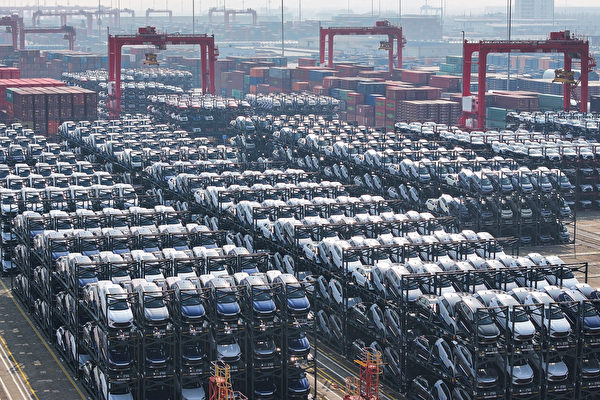In recent months, both U.S. Treasury Secretary Yellen and German Chancellor Scholz have visited China and raised concerns about China’s overcapacity issues, including excess capacity in the automotive industry, which the Chinese authorities have denied. However, data released by the Chinese authorities indicated that the utilization rate of the automotive production capacity is less than 50%, which qualifies as “severe overcapacity”.
According to a report released by the Jiangsu Intelligent Connected Vehicles Innovation Center on April 26, the combined production capacity of the top 20 passenger car companies in China is approximately 35 million vehicles, accounting for about 70% of the total, yet the overall average utilization rate is less than 50%.
An utilization rate between 80% to 85% is considered relatively healthy and sustainable, with over 60% ensuring basic operational functionality for companies. When the utilization rate falls below 60%, it signals “severe overcapacity”.
Data from the “Gaishi Auto” platform indicated that in 2023, China had an overall layout of nearly 55 million passenger cars, with a production of around 26 million vehicles, resulting in an overall underutilization rate of less than 50%. Since 2019, the utilization rate for passenger car production in China has remained below 50%.
The report also highlighted that the overcapacity issue extends to electric vehicles and power batteries. Zhu Ronghua, Chairman of Changan Automobile, mentioned that the projected demand for power battery capacity in China by 2025 is about 1000 GWH, while the industry’s current capacity has reached 4800 GWH. This has led to intense competition in the domestic automotive market, forcing manufacturers to resort to price reductions to stimulate final sales.
Zhuang Jingxiong, the General Manager of SAIC-GM, even admitted in an interview that selling electric cars at a loss is no longer something to be proud of. Hence, both the growth potential in the Chinese automotive market and the lower profit margins brought by domestic pricing wars necessitate Chinese car companies to focus on the overseas market.
In 2019, the Chinese government reduced subsidies for micro electric vehicles, resulting in a significant drop in sales and subsequent bankruptcy for a little-known new energy manufacturer – Zhi Dou Auto. However, with support from the Chinese government-backed funds and investments from dozens of other investors, Zhi Dou was revived by the end of last year.
On April 18, Zhi Dou Auto officially launched its new model, the Zhi Dou Rainbow, offering five models priced between 31,900 to 43,900 yuan, with subsidized prices ranging from 27,900 to 39,900 yuan. These new cars fall under the category of two-door four-seat micro electric vehicles, focusing on pure electric micro-cars.
Professional automotive evaluation and buying media “Buying Cars” expressed surprise at the revival of Zhi Dou Auto, stating, “It’s hard to believe! Zhi Dou Auto has actually made a comeback, named Rainbow this time, what’s the story behind it?”
Although various indicators have shown that there are too many manufacturers compared to demand, local Chinese officials are excited about the resurgence of companies like Zhi Dou. In March of this year, the Governor of Gansu Province visited Zhi Dou’s local factory and expressed hopes for the company to continue its development and contribute to the new energy automobile industry.
The Chinese government continues to support companies like Zhi Dou, encouraging non-profitable firms to persist in production in the hopes of promoting economic growth, protecting employment, and expanding China’s global electric vehicle business. However, this support, including subsidies to automotive manufacturers, has led to increased global car production, potentially exacerbating the oversupply situation.
Reports have noted that for Chinese car companies, entering the overseas market has transitioned from being an added value to a crucial lifeline. Without a presence in the overseas market, establishing a foothold in the highly competitive domestic market becomes even more challenging.
On April 29, the Wall Street Journal reported that China’s long-standing issue of automotive overcapacity persists, with the total annual production of over 100 domestic brands exceeding the national purchasing capacity of car consumers.
According to capacity data from Shanghai strategy firm Automobility and sales data from the China Passenger Car Association (CPCA), China’s annual automotive production currently stands at around 40 million vehicles, while domestic sales are only about 22 million vehicles.
The Wall Street Journal mentioned that this has triggered a fierce price war, with companies like Tesla and others cutting prices in China. The U.S. and Europe are concerned that Chinese automakers may attempt to sell a large number of unsold cars domestically in other countries.
The overcapacity issue is particularly glaring in traditional fuel vehicles, but electric vehicles also face overcapacity problems, with too many companies vying for market share. According to Stephen Dyer, an automotive consultant in Shanghai from global consultancy AlixPartners, there were 123 brands that sold at least one electric vehicle in China last year.
Despite the 27.5% total tariff imposed by the U.S. on imported Chinese cars, Washington remains apprehensive that Chinese companies might try to flood the U.S. with subsidized cars. Europe conducted an investigation into subsidies for Chinese electric vehicles last year, and it is likely to impose import duties in the coming months.

